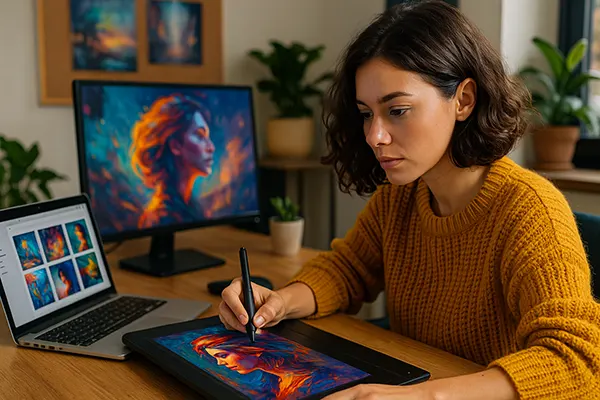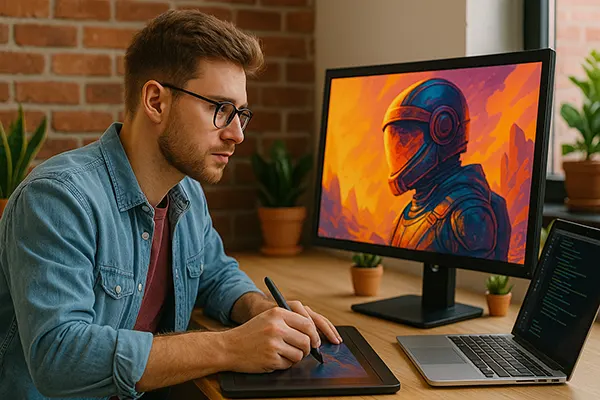How to Start Selling NFT Artworks from Scratch: A Designer’s Guide

In recent years, NFT artworks have become more than a fleeting trend—they’ve opened new revenue streams for digital creators. Even designers without teams or coding skills can now create, market, and profit from their own unique collections. This guide explores real-world tactics and current tools available in 2025 to help you break into NFT art independently and successfully.
Creating Unique Visuals Without Design Skills
You don’t need to be a professional illustrator to launch a compelling NFT series. Thanks to modern tools like Canva and Leonardo AI, even beginners can design visually stunning pieces. Canva offers pre-made templates and easy drag-and-drop functionality, which is ideal for typography-based or minimalistic NFT collections. Leonardo AI goes one step further by letting users generate high-quality artwork through text prompts and AI styling.
In 2025, Leonardo AI introduced dynamic layers and style transfers, making it possible to produce variations from a single prompt. This is particularly useful for generative art, which remains one of the most profitable categories in the NFT market. With free access options and tutorials available, creators can get started without any upfront investment.
Another benefit of these tools is speed. While traditional design might take hours or days, AI-assisted platforms reduce this to minutes. Many independent artists report creating an entire 100-piece NFT collection in just one weekend using these tools, a timeline unthinkable just a few years ago.
Best Practices for AI-Driven NFT Creation
Although AI can help produce images quickly, it’s essential to add a layer of originality. Adjust prompts, remix outputs, or manually refine images in Photoshop to avoid duplication. Projects that show thoughtful curation and thematic consistency stand out in crowded marketplaces like OpenSea or Rarible.
Ensure that each NFT is visually distinct and accompanied by metadata—titles, descriptions, and unlockable content. This adds value and appeal for potential collectors. Use Canva or Figma to create consistent branding across your collection, including preview cards and collection banners.
Finally, test your collection with small private audiences on Discord or Reddit before launching publicly. Feedback can guide improvements and help fine-tune your visual style to better resonate with buyers.
Where to Sell Your NFT Artworks
Two of the most beginner-friendly NFT marketplaces are OpenSea and Rarible. Both support Ethereum and other blockchains, and they allow creators to mint NFTs without writing code. OpenSea’s “lazy minting” lets you list items without paying gas fees upfront—perfect for new artists testing the market.
Rarible, on the other hand, provides greater customisation in how NFTs are presented and even allows for community governance. In 2025, Rarible added integration with Arbitrum and Solana, making transactions faster and cheaper—features particularly attractive to price-conscious buyers.
Before listing, make sure your crypto wallet (e.g. MetaMask) is set up and connected. Both platforms offer step-by-step guides to walk you through the process of creating a storefront, uploading NFTs, and setting royalty percentages, which range from 2.5% to 10% depending on your preferences.
Building Trust and Visibility on Marketplaces
When starting out, your NFT collection is unknown—so trust matters. Write a clear artist bio, include a profile photo, and describe your project’s concept in detail. Collections with transparent creators tend to perform better.
Join verification programs offered by these platforms to get a “Verified Creator” badge. This small mark can significantly increase visibility and trust. Update your profile regularly with new works or announcements to keep your page active.
Consider offering bundles or limited-time discounts for your first few buyers. These small incentives can help your first sales and increase traction, which in turn boosts visibility via marketplace algorithms.

Finding Your First Buyers via Discord and Reddit
Social discovery remains essential in the NFT space. Platforms like Discord and Reddit are where collectors hang out, discuss trends, and discover new projects. Join servers like “NFT Community Hub” or subreddits such as r/NFT and r/NFTsMarketplace. There, you can share your project and gather feedback before launch.
Reddit users prefer detailed project descriptions and are highly sceptical of low-effort promotions. Focus on authenticity and community contribution. On Discord, host AMA sessions or giveaways to build a small fanbase. Consistent presence builds your identity as a real creator, not a spammer.
In 2025, a growing number of NFT buyers report discovering their favourite projects through these channels rather than marketplaces directly. Being active and helpful in conversations often leads to organic exposure and stronger connections with early supporters.
Creating an Engaged Community Around Your Work
Start by setting up your own Discord server or Telegram channel once you’ve gained a few initial supporters. Use these spaces to offer exclusive previews, airdrops, or behind-the-scenes content. This encourages repeat engagement and helps build brand loyalty.
Reddit AMAs (“Ask Me Anything”) can be scheduled via NFT-related subreddits. Make sure you announce your session in advance and provide visual materials to showcase your art. These sessions help validate your credibility in front of thousands of potential buyers.
Don’t just promote—interact. Share your learning journey, tools you use, or design tips. Being perceived as approachable and transparent increases your chances of collaboration and helps grow your collector base organically.
